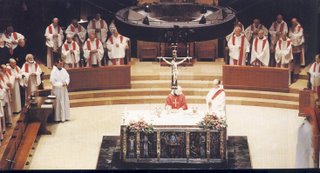 The Pope met with more than a thousand religious superiors of both men and women and noticed the failed reforms that were initiated by some religious communities. Basing it on his earlier theological treatises, he noted their failure to offer the ‘life-giving face of Christ.’
The Pope met with more than a thousand religious superiors of both men and women and noticed the failed reforms that were initiated by some religious communities. Basing it on his earlier theological treatises, he noted their failure to offer the ‘life-giving face of Christ.’
Then he encouraged them to a deeper fidelity to the Gospel and the Church. “To belong to the Lord, to live chaste lives, to be poor in spirit and obedient to Christ, deeper fidelity… ” He was encouraging them to the theological virtue of faith. Why? Did he notice the absence of faith?
“. . . To be a credible sign that the Gospel can be lived today. . . ” That is Charity. He gave them the reason for their failed reforms. Either there was no reform or the reforms took a wrong turn. Instead of going back to the roots of Religious life and the roots of the Gospel which were necessary for the attainment of faith, Religious communities embraced the secular culture. Instead of going supernatural, they went secular. Isn’t this nominalism? When and how did this happen?
Moral theologians noticed that there was a sudden change in the teaching of Catholic Doctrine after the Council of Trent. It could have started earlier. No one is blaming the Council which produced the richest documents, so much so there was no need for a new Council for the next 300 years. No one can really pinpoint how the change came about. But then, Trent moralists noticed the great divorce between Dogmatic and Moral theology, between Ascetical and Mystical theology, between Liturgy and Asceticism and between Old Testament and Evangelical morality. . . fragmented knowledge that is not Catholicism. From this divorce, a broken Church emerged. Moralists mentions William of Ocham and Scaramelli who started the divorce, Emmanuel Kant who finalized it and Abbe Loisy who nailed the coffin. By the end of the 17th century the divorce was complete and the Church was like a broken family. Such a family can only produce delinquent children.
Reformation is laborious job, and only God can reform the Church. He does it by raising up inspirational saints who inspires us to the perfection of Charity, like St. Joan of Arc. Or He raises up renewal saints who remind the Church of the right way of doing things and where she went wrong. Sometimes He raises up only one saint, like St. Alphonsus Liguori in his century. Sometimes, two saints, like St. Vianney, who wrote a simple and attractive catechism, and St. Therese who wrote on Charity in her “Story of a soul.”
The consequent problem caused by the divorce between dogmatic and moral theology that occurred around the 15th century, wherewith this error was incorporated into most manuals of Moral theology taught to seminarians in all seminaries, is that most priests from that century up to the present seem to be ignorant of the complete content and appropriate method of teaching Catholic doctrine. So priests and parishioners have been ignorant of Catholic teachings, except for souls who learned, in a providential way, their religion from the Fathers, or from St. Alphonsus or through St. John Vianney and St. Therese.
God, aside from raising doctors of the Church, guided a group of theological professors to rediscover the proper way of teaching theology in Tubingen. They would teach a young priest named Joseph Ratzinger. But being overwhelmed by student activism, this era in that school in Tubingen, was short-lived. Fr. Joseph Ratzinger would one day compare the right from the wrong way of teaching in his “The New Evangelization” early in his papacy.
All of us are products of this great divorce. And this is the only reason why the Pope expressed his disappointment to the Religious Superiors for not having presented the life- giving, true face of Christ. Probably they have never met Him in faith due to their defective training.
As usual, God has come to the rescue in directing the steps of the Church by raising the present Holy Father who with his Compendium, in imitation of John Vianney, and with his first encyclical “Deus Caritas est”, in imitation of St.Therese, has corrected the error of Nominalism and is directing the barge of Christ towards God. (Picture is the priest-monks of Montserrat, Barcelona, Spain, concelebrating at Mass.)

